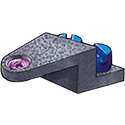DECORATION & FINISHING
Historically, watchmakers began decorating the plates and then the bridges of their movements to hide the manufacturing marks on these components. It was during the 18th and 19th centuries that the decoration of movements became a valuable art with the development of crafts (engraving, enamelling, gem-setting, etc.).
The term “finishing” is often used when referring to the technical completion of a component (e.g., pivot polishing, blocked polishing of an escapement wheel, etc.).
Although often purely decorative in nature, decoration and finishing often provide improvements in the performance and durability of movements.

CHAMFERING
Chamfering is a manual or mechanical operation that creates a chamfer on the sharp edge of a component. Chamfering refines the component’s silhouette and, when polished, elegantly contrasts with the matte surfaces of the movement.

CIRCULAR GRAINING (PERLAGE)
Whether done manually or mechanically, circular graining involves decorating a surface with concentric overlapping circles. This method is usually used for decorating recessed surfaces. Traditionally, the recesses made in the plate and the bridges are decorated with circular graining (perlé).

GENEVA STRIPES (LES CÔTES DE GENÈVE)
Geneva Stripes are used to decorate the upper and flat surfaces of certain components (mostly bridges, plates, oscillating weights, and sometimes dials). Geneva Stripes feature parallel or concentric “waves” (referred to as circular Geneva Stripes). Unlike circular graining, Geneva Stripes are not used to decorate the bottom of a recess.

SAND-BLASTING AND SHOT-BLASTING
Used to achieve a neutral and matte surface finish with the help of a machine that propels sand or particulate grains under high velocity (sand-blasting machines).

SATIN FINISH
The satin finish is achieved through abrasion. It can be applied to flat, convex, or concave surfaces. The lines created by the satin finish are linear and parallel. Satin finishing is often used to decorate the vertical contours of a component.

POLISHING
Polishing involves the mechanical or manual treatment of a surface to make it as smooth and shiny as possible. To achieve this, the surface is polished using progressively finer (softer) abrasives. In addition to its decorative properties, polishing can, technically, help reduce friction or provide better resistance to corrosion.

SUNBURSTING
Similar to satin finish, sunbursting creates lines through abrasion on the surface of the component to which it is applied. In this case, the lines obtained are not parallel but radial. This decoration is perfectly suited for circular components or surfaces of circular components (e.g., a barrel or a crown wheel). Appreciated for its iridescent effects, sunbursting is also often used to decorate the surface of a dial.

ENGRAVING
In horology, engraving can serve either an indicative or purely decorative purpose. The manufacturer’s mark, the calibre number, or the number of jewels it contains are examples of information that is usually engraved on a caseback of a watch today. Engraving done by hand is seldom and exclusively ornamental. Various engraving techniques are available (hand engraving, mechanical engraving, chemical engraving, laser engraving, or even photovoltaic engraving), offering a wide range of work quality and its cost.

ENAMELLING
Enamelling is often a subject of controversy and inaccuracies. There are various techniques of enamelling. However, enamel is, above all, a demanding material. It is a precise mixture of silica, red lead, potash, and soda. The addition of specific oxides allows for a wide range of defined colours. The resulting powder is mixed with a binding agent. Once liquefied, the enamel can be applied with a brush. The enamel takes on its colour, transparency, and, most importantly, its hardness after being exposed to high temperatures.

SKELETONIZING & OPENWORK
These two techniques involve creating openings in the solid surfaces of components. Openwork refers to partial surface openings or openings that only extend to the lower level of components (an open dial, an open bridge). Openwork is generally used to reveal specific parts of the movement. Skeletonization aims to maximize the lightness and thinness of the movement’s structure to achieve maximum “transparency.” A movement is considered skeletonized when the light can pass through it from one side to the other.

GEM SETTING
Setting is the process of putting stones in place and holding them by claws or metal edges that are folded over the stone.

CIRCULAR GRAINING (CERCLAGE)
Like satin finishing and sunburst, circular graining creates fine lines by abrasion of the surfaces. In the case of circular grinding, these lines are circular and concentric. Therefore, it is mostly used to decorate round-shaped components (e.g., the flat surface of a screw head).

ENGINE-TURNING
(guilloché)
Engine-turning or “guilloché” is a type of engraving that involves creating decorative patterns composed of interlaced lines. Engine-turning can be done by hand, on an ornamental lathe (usually a completely manual tool), or by any other engraving method (mechanical, chemical, etc.). The light reflections achieved through engine-turning make it a particularly elegant decoration.

GRUNGE POLISHING
Grunge polishing is a preparatory operation that accompanies other decoration or manufacturing operations. Its goal is to reduce the machining or filing marks from previous operations. For example, when filing a piece’s surface, the movements of the file will leave marks in the material oriented along the filing axis. Grunge polishing involves lightly filing the surface while constantly changing the axis. This will make the file marks less pronounced and the surface smoother, saving time for subsequent operations (satin finishing, polishing, etc.).

CHAMFER
Chamfer is a concave circular angle made at the top of a hole (e.g., a screw or stone hole) using a beveling cutter. Typically polished, a chamfer indicates a certain level of finishing.
BECOME A CONTENT CONTRIBUTOR
HOROPEDIA is a participative knowledge platform and we invite all those who wish to contribute to this adventure of sharing watchmaking knowledge to join us.
It can be additional explanations, images or other illustrations or terms not yet identified that deserve to be.
